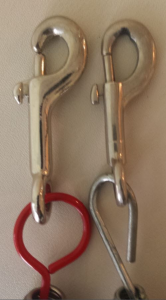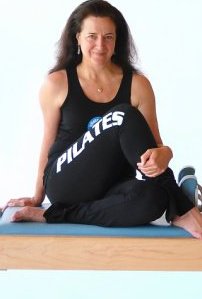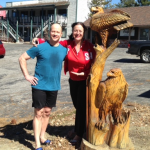Pilates Too Many Accidents and Injuries – by Siri Dharma Galliano
 Helping people to be healthy is the reason we teach Pilates. Having people get injured while using Pilates equipment is something that we never intended. However, more and more accidents seem to be happening.
Helping people to be healthy is the reason we teach Pilates. Having people get injured while using Pilates equipment is something that we never intended. However, more and more accidents seem to be happening.
Why? More people are practicing Pilates than ever before; some brands of equipment (generally constructed outside of US) are not being made with the same standards of construction; some studios are using older equipment and the studio owner is either unaware or unwilling to buy replacement parts; used equipment is being recycled without the necessary preventive care and tune-ups; teachers have less education about equipment than necessary; little opportunity for in-studio apprenticeship in today’s certification-centric market; and non-traditional (and unexpected) exercises are being performed on the apparatus.
If someone breaks a shoulder, ankle, or nose, there can be a lawsuit (and in the litigious United States, a $1 million liability insurance policy will not be enough if you are found liable for $2 million of damages due to your client’s loss of function or disfigurement). Although the client may have signed a waiver (acknowledging accidents do occur), if you are found negligent, it is your assets that will be liquidated to satisfy the judgment. Do you think having a limited liability corporation protects you? You can also be sued personally.
In order for a victim’s lawyers to determine who was at fault, they frequently call on me as a leading Pilates equipment expert to determine who is liable: the teacher, the studio owner, the client, the manufacturer, the service technician, ….
To reconstruct the “crime scene” there are many questions to resolve: Where was the teacher standing? What was the instruction given? Was it even “Pilates” (and is this consistent with the training the student paid for and that the teacher has is qualified to provide)? Was the instructor trained on a different brand of apparatus than the one being used? When was the last maintenance and safety check? Was the technician qualified/certified on this brand of apparatus?
Here are just a few examples of common accident areas to be aware of:
Springs:
1. Often overstressed, especially on combo units. For example, on an adjustable push-thru bar, using a lower or higher setting changes the force of the intended spring. Where there is metal on metal contact, wear will occur.
2. Springs are being used to wrap the push-thru bar or swing around the poles and that opens the coils.
3. Springs on the reformer are left in the wrong gear and extended, instead of slack


Eye-hooks and pulleys:
Wherever there is metal screwed into wood instead of welded, expect that it will become unscrewed
1. Where springs and strap connect to swing or frame on Trap Table
2. Where straps connect to frame on Reformer or Chairs.
3. Where pulleys connect to frame on Reformer
Straps:
1. They are old and the clips have never been replaced
2. The stitching is not strong enough to support a large student’s weight
3. The apparatus is different from brand to brand. For example, on Allegros, the box may be too high and, when the strap is placed outside of the frame, this can be too tight and muscles can get torn
The High or Low Chair:
1. Foot gets caught in pedal.
2. Open ended springs or hooks
3. Shins and knees get damaged from split-pedal pole (not a Joe Pilates invention)
Teacher Problems:
1. Lack of training in where and how to spot the body and the equipment. For example, on the short box, the strap is placed on toes instead of high on the ankle and the foot slips because the teacher is not trained in where the strap belongs
2. The ratio and resistance level is not matched to the size or ability of the student. For example, using a spring on Snake/Twist that is too light can cause a tear in the shoulder while using a spring on Pull-Ups on the Chair that is too heavy and your student can slingshot right off the apparatus.
3. “Fusion” and “Evolved” Pilates. For example, placing a foam roller on the Trapeze Table and having client on top of it when they are doing roll-down bar exercise. An older (or less capable) client can easily fall off the table and get injured.
Studio Owner:
1. Hiring someone not qualified (“certified” does not mean “qualified.”)
2. Studio cluttered with balls, boards, barrels, and weights. People can trip, fall into apparatus, get injured.
3. Buying cheap (poverty consciousness). Not changing out springs or parts when they are worn; Using cheap plastic parts on combo units to hold the shoulder blocks in place when all shoulder rests are dangerous if not welded.
Let’s face it, an accident is just that, an accident. It happens: A momentary lack of concentration, gossiping and chatting, a wandering mind, or just bad luck, and you can be in a terrible situation in seconds. Many “accidents” can be avoided with forethought, preparation, and attention to detail – fixing the small problems before they become big problems.
Do be prepared. Keep ice packs in the studio for pulled muscles and sprains. Have bandages and a good first aid kit, in case you have to cover a broken bone or punctured eye while waiting for appropriate medical assistance.
In the beginning of our Pilates experience, we have a heightened awareness of our bodies moving on the equipment and with familiarity, we lose that. Keep your focus. Don’t be distracted. When in doubt, always go back to Originalism – how is the apparatus used and set up for the next trick? The purpose of Pilates is to prevent suffering, not cause it.

 Siri Dharma Galliano is one of the leading Pilates trainers in North America and Europe. She is a renowned New York Pilates instructor with over 20 years of experience, she has trained actors on location in feature films such as The Matrix 2, The Matrix 3, Batman, and the Kill Bill films. In addition to her studio and film work, Ms. Galliano has traveled the world helping to sculpt the bodies of celebrity clients such as Madonna, Sting, Uma Thurman, Cameron Diaz, Carrie- Anne Moss and Jessica Lange.
Siri Dharma Galliano is one of the leading Pilates trainers in North America and Europe. She is a renowned New York Pilates instructor with over 20 years of experience, she has trained actors on location in feature films such as The Matrix 2, The Matrix 3, Batman, and the Kill Bill films. In addition to her studio and film work, Ms. Galliano has traveled the world helping to sculpt the bodies of celebrity clients such as Madonna, Sting, Uma Thurman, Cameron Diaz, Carrie- Anne Moss and Jessica Lange.
Ms. Galliano’s unique approach to fitness brings students an awareness of Pilates techniques and health traditions regardless of their age or physical condition. Her instruction incorporates a combination of focus, joy and a refreshing sense of humor.

